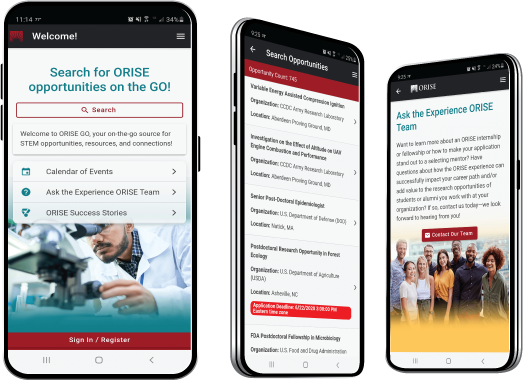USGS Climate Adaptation in Pinyon-Juniper Woodlands Fellowship
To submit your application, scroll to the bottom of this opportunity and click APPLY.
A complete application consists of:
- An application
- Transcript(s) – For this opportunity, an unofficial transcript or copy of the student academic records printed by the applicant or by academic advisors from internal institution systems may be submitted. Click here for detailed information about acceptable transcripts.
- A current resume/CV, including academic history, employment history, relevant experiences, and publication list
- Two educational or professional recommendations. At least one recommendation must be submitted in order for the mentor to view your application.
- A copy of an abstract or reprint of an article
All documents must be in English or include an official English translation.
Connect with ORISE...on the GO! Download the new ORISE GO mobile app in the Apple App Store or Google Play Store to help you stay engaged, connected, and informed during your ORISE experience and beyond!”
USGS Office/Lab and Location: A research opportunity is available with the U.S. Geological Survey (USGS) located at Fort Collins, Colorado.
The USGS mission is to monitor, analyze, and predict current and evolving dynamics of complex human and natural Earth-system interactions and to deliver actionable intelligence at scales and timeframes relevant to decision makers. As the Nation's largest water, earth, and biological science and civilian mapping agency, USGS collects, monitors, analyzes, and provides science about natural resource conditions, issues, and problems.
Research Project: Land managers need two fundamental pieces of information to enable effective climate adaptation in PJ woodlands. First, managers need to know how climate change will alter the ecological potential of their PJ woodlands (e.g. the potential distribution of plant species, and the potential plant species and vegetation structure than can be supported at a given site). Awareness of future ecological potential can help define objectives for species and structural conditions that should be targeted in restoration and land treatment practices. Second, managers need to know how changes to vegetation structure, driven by disturbances and/or vegetation treatments, influences a) patterns of drought and moisture availability, including the probability of extreme events both favorable extremes that enable tree regeneration and unfavorable extremes that lead to plant dieback and mortality, and b) the risk of catastrophic, stand-replacing wildfire. This project is designed to help meet some of these information needs, focused on PJ woodlands in the Colorado Plateau region. Our overall goal is to provide knowledge and datasets that inform long-term climate adaptation planning and prioritization of PJ woodlands by addressing three specific objectives:
Objective 1: Assess vegetation treatments and disturbance impacts on patterns of moisture, both typical conditions and extremes (positive = regeneration; negative = mortality). This objective will integrate ecosystem water balance modeling techniques (see below) with existing datasets of field-observed microclimate measurements (e.g. temperature and soil moisture) under various vegetation structural conditions.
Objective 2: Evaluate how climate change will alter patterns of drought and ecological potential across PJ woodlands in SW Colorado. This objective will focus on the ecological site groups (ESGs) that Duniway et al have developed for the region, capitalizing on the established links between ecological site groups and vegetation (e.g. ecological potential). For each ESG, we will estimate the soil moisture and climate conditions that characterize the ESG under historical conditions. We will then identify how the location of those particular conditions will shift in coming decades (using future simulations). These results will provide spatially-explicit information about how ecological site groups are likely to move in the future, and thus how the plant communities and vegetation structures that those site groups support will shift across the landscape. We will also evaluate the level of confidence in long-term projections of changes in soil moisture and ecological potential by evaluating the consistency of changes among climate models and representative concentration pathways (e.g. emissions scenarios).
Objective 3: Identify site-specific optimal vegetation treatments for minimizing extreme fire behavior, minimizing drought-induced tree mortality, and maximizing potential tree regeneration and recruitment. This objective will integrate results from objective 1 about how vegetation structure impacts soil moisture with results from objective 2 about how and where climate change will alter the distribution of ESGs and ecological potential. Simulations will examine the simultaneous effects of both climate change and vegetation treatments to identify where vegetation treatments may be effective for promoting resistance to wildfire and resilience to drought and biological invasions. This objective is designed to inform BLM field office staff planning vegetation treatments in specific locations, so the analysis will be structured at sufficiently high resolution to provide the necessary site-specific information, and results will be made available via accessible tools and documents.
Learning Objectives: Under the guidance of a mentor, the participant will learn about climate adaptation, ecology, and forestry.
Mentor: The mentor for this opportunity is John Bradford (jbradford@usgs.gov). If you have questions about the nature of the research, please contact the mentor(s).
Anticipated Appointment Start Date: 2025. Start date is flexible and will depend on a variety of factors.
Appointment Length: The appointment will initially be for one year but may be renewed upon recommendation of DOI and is contingent on the availability of funds.
Level of Participation: The appointment is full time.
Participant Stipend: Stipend rates may vary based on numerous factors, including opportunity, location, education, and experience. If you are interviewed, you can inquire about the exact stipend rate at that time and if selected, your appointment offer will include the monthly stipend rate.
Citizenship Requirements: This opportunity is available to U.S. citizens only.
ORISE Information: This program, administered by ORAU through its contract with the U.S. Department of Energy (DOE) to manage the Oak Ridge Institute for Science and Education (ORISE), was established through an interagency agreement between DOE and USGS. Participants do not become employees of USGS, DOE or the program administrator, and there are no employment-related benefits. Proof of health insurance is required for participation in this program. Health insurance can be obtained through ORISE.
Questions: If you have questions about the application process, please email USGS@orau.org and include the reference code for this opportunity.
The qualified candidate should have received a doctoral degree in one of the relevant fields. Degree must have been received within the past five years.
- Citizenship: U.S. Citizen Only
- Degree: Doctoral Degree received within the last 60 month(s).
-
Discipline(s):
- Environmental and Marine Sciences (4 )

 ORISE GO
ORISE GO

The ORISE GO mobile app helps you stay engaged, connected and informed during your ORISE experience – from application, to offer, through your appointment and even as an ORISE alum!





